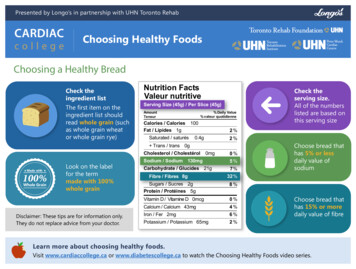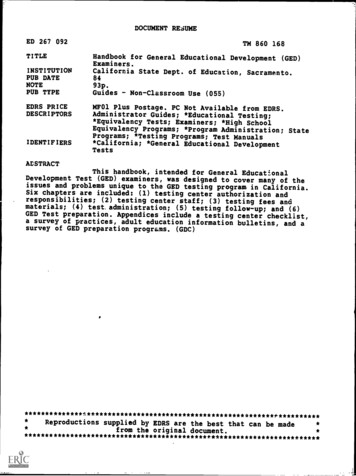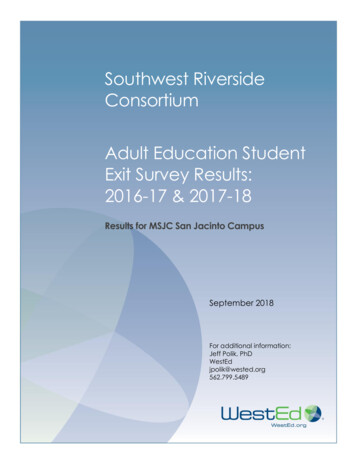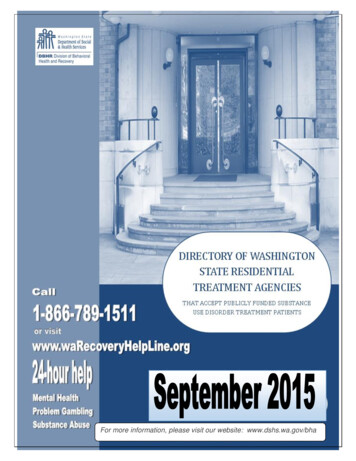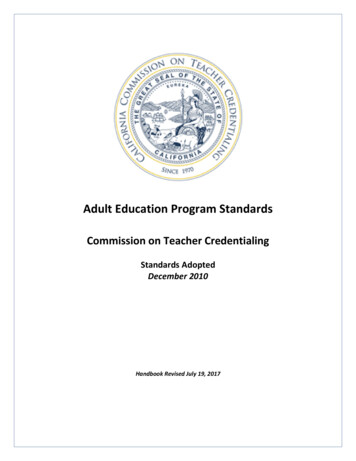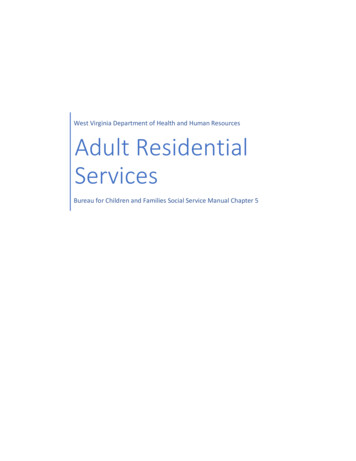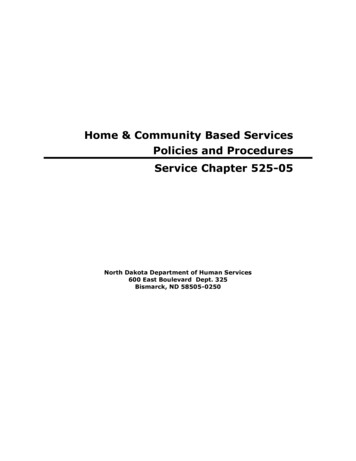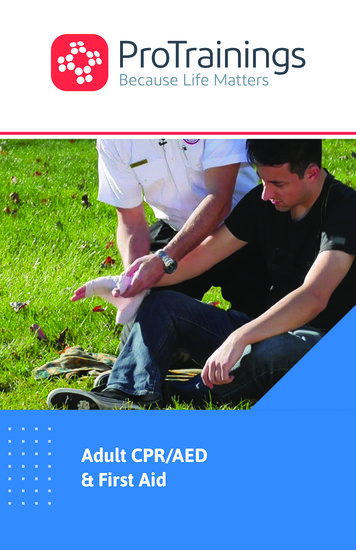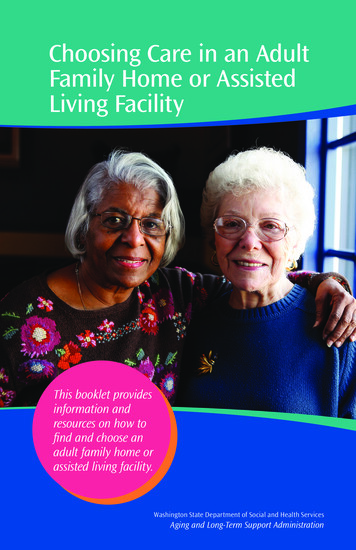
Transcription
Choosing Care in an Adultfor Individual ProvidersFamily Home or AssistedLiving FacilityThis booklet providesinformation andresources on how tofind and choose anadult family home orassisted living facility.Washington State Department of Social and Health ServicesAging and Long-Term Support Administration
Are you looking for housing andcare options for yourself or anotherperson? There are many things toconsider, terms that may be new, andhousing and service conditions toexplore prior to making a decision.This booklet offers some steps totake and questions to ask to help youget the information you need toknow if an adult family home orassisted living facility is the rightoption for you.
If you or a loved one need more care than youcan get at home, it may be time to exploreresidential care. Residential care is a term usedto describe a home or facility where an adultcan live and get help with care in a communitysetting.There are many residential care options thathave become available over the last severalyears. Each type of residential care home offersdifferent housing and care service options.It is important for you to understand thedifferences in residential options available andhave a good idea of what services are needed.You can then match your needs and preferenceswith a particular residential option.This booklet describes two residential options:adult family homes and assisted living facilities.Both are licensed by Washington State.There are other non-licensed housing optionsnot covered in this booklet, includingretirement communities and continuing careretirement communities. More information isavailable about these options through your localSenior Information and Assistance Office.For more information, see page 5 or visit:www.dshs.wa.gov/altsa.1
Six stepsto finding the righthome for you:Step 1:Talk About Life ChangesStep 2:Review NeedsStep 3:Get the InformationYou NeedStep 4:Get a List of AdultFamily Homes andAssisted Living FacilitiesStep 5:Set up VisitsStep 6:Make a DecisionWhat are Adult Family Homes and AssistedLiving Facilities?An adult family home (AFH) is licensed to providehousing and care for up to six adults in a regularhouse located in a residential neighborhood. TheAFH may be run by a family, single person, orbusiness partners. The AFH may also hire otheremployees. Some AFHs allow pets. In some homes,multiple languages are spoken.An assisted living facility (ALF) is licensed toprovide housing and care to seven or more peoplein a home or facility located in a residentialneighborhood.All AFHs and ALFs provide housing andmeals (room and board) and assume generalresponsibility for the safety and care of theresident. Additional services may be offered,including:¡ Varying levels of assistance with personal care.¡ Intermittent nursing care (a nurse available on apart-time basis).¡ Assistance with or administering of medications.Some AFHs and ALFs also provide specializedcare to people living with developmentaldisabilities, dementia, or mental illness.This booklet outlines six steps that willhelp you get the information you need todecide if an adult family home or assistedliving facility is the right choice for you.2
Step 1: Talk About Life ChangesThe first step in making long-term care decisions is for everyone involved toovercome their reluctance to talk about it. Many people put off thisconversation because they are uncomfortable or unsure about how to bring itup. The person needing additional care may be reluctant to admit theirchanging needs. Family members can have differing opinions about whatshould happen. Miles can separate concerned loved ones.No matter what the circumstance, fear and discomfort can leave everyoneunprepared if a crisis occurs. Start talking now before an unexpected life crisisteaches you all the things you wished you had known ahead of time.Tips for Talking About Life Changes¡ Set aside time to talk when everyone is rested and prepared.¡ Do some homework and have some knowledge about what types of housingand care services are available where you live.¡ The person requiring additional care and support should have a central rolein determining what is needed and how it is accomplished.¡ Allow each person to talk without interruptions or criticizing.¡ Understand emotions are a big part of this discussion.¡ Be patient with the amount of time that may be needed to get things out onthe table.¡ Remember, it normally takes more than one conversation to figure out whatto do. Do not try to tackle too many issues at once. Many small steps arebetter than one huge leap that leaves everyone upset and more confused.¡ Stay positive. It is normal to find change difficult.¡ Allow everyone time to think abouteverything discussed. If helping a lovedone – remember you are makingrecommendations not decisions.The wishes andpreferences of theperson who will live inthe adult family homeor assisted living facilityare the most importantpart of this process.3
Step 2: Review NeedsCarefully consider what care and help you, or your loved one, need. Make alist of medical, physical, and social needs.For example:¡¡¡¡4Does someone need to do laundry and cooking?Is help needed to get to the bathroom or dressing?Are regular medication reminders necessary?What type of help is needed so the person can stay socially connected?
Step 3: Getting the Information You NeedMuch of the initial information gathering begins on the telephone. There are somany resources available it can be hard to know where to begin. It is helpful toknow that it is a time consuming process for everyone. Plan accordingly.Who to CallCommunity Living ConnectionsThere are local Community Living Connections (CLC) offices throughoutWashington State. CLC provides information about local senior services inthe community. CLC staff can assist with such things as what services may beavailable and their cost, names and addresses of local adult family homes andassisted living facilities, how to fill out forms, and how to find out about whatbenefits you may have.CLC is part of your local Area Agency on Aging (AAA). To find the CLC orAAA office nearest you, go to www.waclc.org/connect. You can email theoffice directly, or find the local phone number. You may also call the statewidetoll-free number at 1-855-567-0252.Home and Community ServicesIf you think you may need state funding (Medicaid) to help pay for services,contact your local Home and Community Services (HCS) office. Call yourregional HCS office and request an assessment. Phone numbers and locationsfor local offices are listed on back cover of this booklet.Eldercare LocatorIf you are looking for information and live outside of Washington State, theEldercare Locator is an excellent resource to connect you with local services.Call the Eldercare Locator at 1-800-677-1116. Full language service for 150languages is available when you call. Or, visit them on the internet atwww.eldercare.acl.gov.5
Getting Services in Your Own HomeAlthough this booklet focuses on moving to an adult family home or assistedliving facility, there are many services and resources available to help an adultget the care needed to continue to live at home. Any of the resources listedunder “Who to Call” section of this booklet can also assist with in-homeservice options.Another DSHS booklet, Medicaid and Long-Term Care Services for Adults(DSHS 22-619), describes many of the available in-home services. See page 14for ordering information or go online to: www.dshs.wa.gov/sesa/publicationslibrary and search by the publication name.Step 4: Get a List of Adult Family Homes and AssistedLiving FacilitiesThere is a wide range of adult family homes and assisted living facilities inWashington State. To begin finding the home that is a good fit for you or yourloved one, visit: ng-termcare-residential-options.This list provides the phone numbers and addresses of thefacilities in the area requested. It also lists what contract(if any) the facility holds with the State toprovide care for state-funded residents.If you do not have a computer at home,check with your local library foraccess to one.Your local Community LivingConnections Office, AreaAgency on Aging or Home andCommunity Services officecan also provide a list ofavailable options.6
Step 5: Set up VisitsOnce there is a list of possible homes, you need to visit homes that match yourneeds. This point is very important. Visit as many potential homes as you canat different times of the day.Although setting up these visits may appear time consuming, in the long runit is worth taking this time to make the best decision. Visiting homes helpsyou compare the options available and get a good feel for what is available.Find out more about the reputation of each home you visit by:¡ Asking a representative from the home you are visiting to: Show you the last state inspection report. This report will give you insightinto any potential problem areas of the home. Give you a copy of thedisclosure form that sets out the care and services that the assisted livingfacility offers. Provide references or numbers to contact former residentsor their family members.¡ Viewing any history of complaints against a facility by going online to: ls-providers. Under the“Find an Adult Family Home” or “Find an Assisted Living”, reports will belisted for each facility.¡ Contacting the local Long-Term Care Ombudsman Program for your area.Long-Term Care Ombudsman Program representatives are advocates forresidents of residential care facilities. They work to resolve problems ofindividual residents and to bring about changes at the local, state, andnational levels to improve care. They can be an excellent source ofinformation.To find the office nearest you, call their toll-free numberat 1-800-562-6028.7
Step 6: Make a DecisionThe following checklists will help you ask questions and get information tomake your decision. Do not hesitate to ask as many questions as you need tomake a choice that works for you. Although there are many questions here,the most important thing to ask is, “Does the adult family home or assistedliving facility meet my needs?”Costs and FinancesWhat is the basic rate for room, board, and services? (it is a good idea toget this information in writing)What services are covered by this rate?Are there other services available and how much do they cost?What are the payment policies?What is the refund policy if someone leaves before the end of amonth?What is the policy for rate increases?What is the policy for accepting Medicaid or transferring to Medicaid at alater date?There are important things to know if you think you will need Medicaid(state funds) to help pay for care now or in the future. For moreinformation, read the DSHS booklet Medicaid and Long-Term CareServices for Adults (DSHS 22-619).Other sources of information are your local HCS office or an attorneywho understands Medicaid rules. See the back of this booklet to learnhow to order the Medicaid booklet and for the HCS office contactinformation.8
Administration and StaffHow long has the current administration been in place?Is there enough staff available to meet my needs?Is there frequent staff turnover?Is some level of nursing care provided (RN, LPN, NursingAssistant)? How often is it available?Who will help me with medications if I need it (e.g. reminding me to takethem, opening the bottle)?Can someone administer medications to me if I can not take them myself(e.g. applying medication to my skin, putting a pill in my mouth)?Can someone help me if I need special care (e.g. caring for a wound)?What happens if I have an emergency? Can I get help right away?Are staff suitably dressed, personable, and outgoing?Do the staff members treatresidents with respectand dignity?Do staff members treateach other in a professionalmanner?What language doesmost of the staffspeak?9
Services and ActivitiesWhat type of help with personal care is available (e.g. bathing, dressing)?How flexible is the schedule for receiving help with personal care?What, if any, transportation services are available? (e.g. medicalappointments, shopping, religious services).Will staff arrange for activities (e.g. hair appointment, concert)?How does the home support and accommodate personal hobbies?Are there regularly planned activities that I will enjoy?Will I be able to attend religious services of my choice?Can I bring my pet with me when I move?SurroundingsAs I arrive, do I like the location and outward appearance?Is the home close to friendsand relatives?Is the home on a noisy street?Are there shops, a library,a park, or other amenities withinwalking distance?Is the home close to activitiesI enjoy?Is the home on a bus line?Is there an outside area to sit, walk,or garden?10
Physical SettingIs the floor plan easy to follow?Are doorways, hallways, and rooms accommodating to wheelchairs andwalkers?Are there hand rails to help with walking and in the bathroom?Are cupboards and shelves easy to reach?Are there nonskid floors and firm carpets to assist walking?Does the home have good natural and artificial lighting?Is the home clean, free of odors, and well heated and cooled?Does the home meet my standards of cleanliness?Is the home free from obvious environmental hazards?Are the home’s rooms clean, safe, and adequate for my needs?Will I have free use of common areas, such as the kitchen, activity rooms,toilet facilities, dining room, or grounds?Can I smoke in my room or in common areas?What furniture is provided?Can I adjust the temperature of my room?Is there a sit-down shower?Can I have my own personal phone line or internet connection?Are emergency procedures clearly posted?Am I able to lock my room and/or are there locked areas in each room forpersonal valuables?11
FoodIs the food pleasing, nutritious, adequate, and attractively served?What if I do not like what is being served?Can I cook in my room?Are snacks available?Are there specific meal times or are they flexible?Is there a refrigerator available to store my personal food?Will the home meet my dietary or cultural food preferences?Can I request special foods?Other ResidentsDo other residents socialize witheach other and appear happyand comfortable?Do residents speak favorably ofthe facility?Do the residents look like peopleI want to live with?How are room changes androommate concerns addressed?Is there a resident group that meets?Do any of the other residents have ahistory of violent or other problembehaviors? How are these situationshandled by staff?12
Once a Decision is MadePlanning and information gathering does not stop once you have made yourdecision to move into an adult family home or assisted living facility. Movingis a major life change. To help ease the transition, use some of the same stepsdefined in the first part of this booklet:1. Talk through the changes that will need to be made.2. Ask staff at the new residence for help with any questions you have.3. Get any other additional information you need.4. Make a plan of what needs to happen and when.Moving to an adult family home or assisted living facility can mean lettinggo of a lifetime of possessions and a familiar way of life. Some people arerelieved and look forward to fewer responsibilities while others find itemotional. Either way, the person making the move needs the full support offamily and loved ones and should have the central role in determining whathappens and when.Once the move has happened, anticipate a normal period of adjustment.The first few weeks can be the hardest as routines get established and thingsbecome more familiar.It is important to discuss any concerns or questions with the adult familyhome or assisted living facility administrator. Be sure to ask for what youneed. The staff may be able to make changes that will better meet what worksbest for you.As a resident of an adult family home or assisted living facility, you alsohave certain consumer rights guaranteed by law (Chapter 70.129 RCW). Theowner or staff at your new residence should inform you of these rights. If not,ask.13
Ordering PublicationsYou may order this booklet and other DSHS publicationsthrough the Department of Enterprise Services (DES) GeneralStore.Go to the DES’s website at:www.MyFulfillment.wa.govPublication requests may also be placed:¡ By e-mail at printing@des.wa.gov¡ By phone at (360) 664-4343¡ By fax at (360) 586-6361Make sure to include the name of the publication, publicationnumber (DSHS 22-xxx), and a contact name and streetmailing address for orders placed by e-mail, phone, or fax.14
Visit:www.dshs.wa.gov/altsaTo Find:¡ Free brochures and booklets on caregiving and long-termcare topics.¡ Translated versions of publications.¡ Telephone numbers and addresses of local offices workingwith seniors.¡ A list of adult family homes, assisted living facilities, ornursing homes by county.¡ Information, Resources, and Programs: For caregivers.On healthy aging.On falls prevention.On long-term care planning.15
We are all partners against adult abuseAbuse of vulnerable adults (people who need help tocare for themselves) can happen anytime, anywhere.DSHS investigates alleged abuse, neglect, exploitation, orabandonment of vulnerable adults.Call the telephone number listed below for help if you orsomeone you know is:¡ Not being cared for properly.¡ Being hurt physically, mentally, or sexually.¡ Being financially exploited in any way.If you suspect abuse, neglect, or exploitation of a vulnerable adult:Call DSHS toll-freeDSHS does not discriminate in serving or contracting with people because of race,color, national origin, gender, sexual orientation, age, religion, creed, marital status,disability, or Vietnam Era Veteran status, or the presence of any physical, mental, orsensory handicap.16
Home and Community Services Regional Phone NumbersSee map to find the region you live in. Call the number listedfor your region and ask for the local HCS office nearest ntyCountySKAGITCountyRegion 2SAN KITSAPGRANTCountyCountyKITTITASGRAYS HARBORCountyCountyPIERCERegion yCountyPACIFICCountyRegion HKIAKUMCountyCountyCOWLITZCountySKAMANIAWALLA CLARKCountyCountyREGION 1REGION 2REGION 257253-476-72001-800-442-5129TTY 509-586-3697Adams, Asotin, Benton, Chelan,Columbia, Douglas, Ferry,Franklin, Garfield, Grant,Kittitas, Klickitat, Lincoln,Okanogan, Pend Oreille,Spokane, Stevens, Walla Walla,Whitman, and Yakima CountiesTTY 1-800-833-6384TTY 253-593-5471Island, King, San Juan,Skagit, Snohomish, andWhatcom CountiesClallam, Clark, Cowlitz, GraysHarbor, Jefferson, Kitsap,Lewis, Mason, Pacific, Pierce,Skamania, Thurston, andWahkiakum Counties17
www.dshs.wa.gov/altsaDSHS 22-707 (Rev. 1/19)
regional HCS office and request an assessment. Phone numbers and locations for local offices are listed on back cover of this booklet. Eldercare Locator If you are looking for information and live outside of Washington State, the Eldercare Locator is an excellent resource to connect you with local services.
